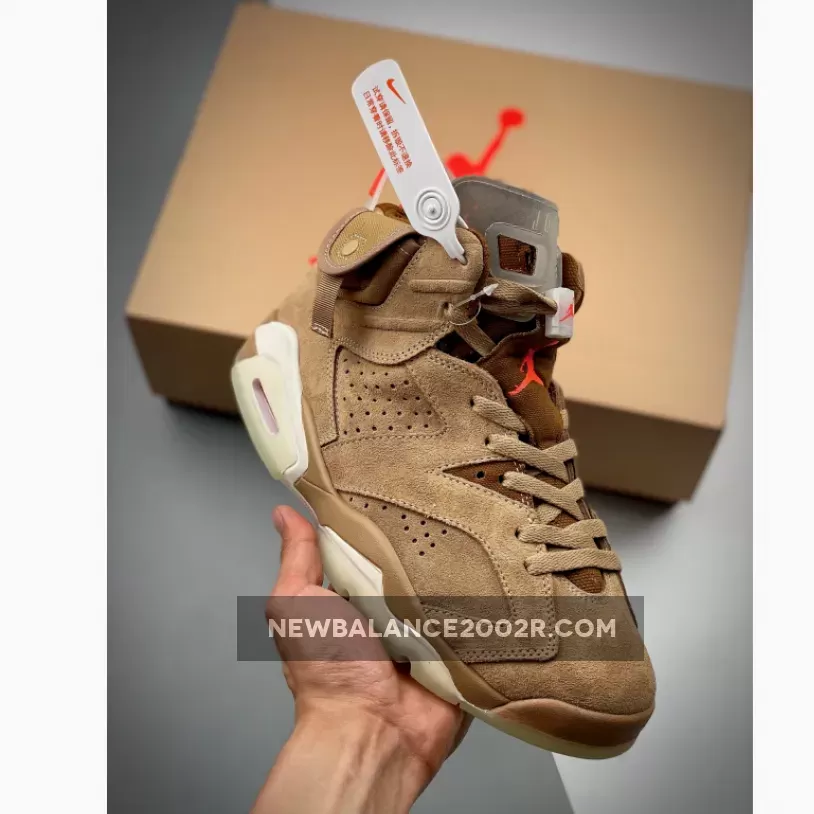The world of sneakers is saturated with replicas, and the highly sought-after Air Jordan 6, with its various coveted colorways like the Travis Scott “British Khaki,” “Yellow,” and the OVO edition, is no exception. The allure of these iconic shoes fuels a massive market for counterfeits, leaving many sneakerheads wondering: How can I be absolutely sure my prized possession is genuine? This isn’t just about dropping hundreds of dollars; it’s about owning a piece of history, a testament to craftsmanship, and a symbol of style. This comprehensive guide dives deep into the intricate details that distinguish authentic Air Jordan 6s from their convincing imitations.
Beyond simply looking at the heel, as many quick guides suggest, true authentication demands a meticulous examination across multiple aspects of the shoe. This process transcends a cursory glance; it’s about understanding the nuances of design, material quality, and manufacturing precision that define a genuine Air Jordan 6.
1. The Heel: The Foundation of Authenticity
The heel counter is often the first point of inspection for counterfeit detection. While the placement of the “NIKE AIR” logo is crucial, it’s the intricacies surrounding it that truly matter. Authentic Jordan 6s showcase precise stitching, with consistently spaced and straight seams. Look for inconsistencies in stitching—irregular spacing, loose threads, or unevenness—as a telltale sign of a fake. The “NIKE AIR” lettering itself should be perfectly aligned and embossed with a depth and clarity that’s difficult to replicate. Pay close attention to the font weight; counterfeit logos often appear too thin, too bold, or lack the crisp definition of the genuine article. The same level of scrutiny applies to the Nike Swoosh logo on the heel—is it correctly shaped, proportionate, and seamlessly integrated into the design?
2. Midsole and Outsole: A Symphony of Detail
The midsole of the Air Jordan 6 boasts a specific shape and texture. Counterfeit versions often fall short in replicating these characteristics. Look for consistent color throughout the midsole, free from uneven fading or discoloration. The material should feel firm and robust, not flimsy or soft. The outsole, responsible for traction and durability, should exhibit crisp details in its tread pattern. Blurred lines, inconsistent spacing, or a lack of depth in the pattern are indicative of a fake. The material itself should feel durable and resistant to bending or deformation.
3. Upper Materials and Construction:
The materials used in constructing the upper play a significant role in determining authenticity. Genuine Jordan 6s utilize premium materials like leather, suede, or nubuck, which possess a distinct texture and feel. Run your fingers across the surface; authentic materials offer a natural texture, a subtle give, and a certain weight. Counterfeits often use cheaper alternatives that feel plasticky, thin, or excessively stiff. Inspect the stitching on the upper, paying attention to the consistency and neatness of the seams. Loose threads, uneven stitching, or gaps between panels are common flaws in fakes.
4. Tongue and Laces:
The tongue of the Air Jordan 6 is another area where authenticity reveals itself. The material should feel consistent with the upper material—matching texture and quality. The embroidered Jumpman logo should be perfectly stitched, with even spacing and sharp definition. The laces should be sturdy and show consistent color and texture. Cheap, flimsy laces are a clear indicator of a fake.
5. Inner Lining and Insoles:
Authentic Air Jordan 6s feature a carefully constructed inner lining. The insole often includes specific branding and details. Compare these details to images of genuine insoles to spot inconsistencies. The insole material should be comfortable and supportive, not thin or flimsy.
6. Box and Accessories:
While not a definitive indicator on its own, the box and any included accessories can provide supplementary evidence. Genuine Jordan 6s typically arrive in a branded box with specific details, including color coordination, proper labeling, and crisp printing. Check the box’s construction and printing quality for any inconsistencies. The presence or absence of additional accessories (like extra laces or a dust bag) should also be investigated and compared to known genuine products.
7. Purchase Source and Price:
Where you purchase your shoes is as important as the shoe itself. Avoid buying from unauthorized resellers or suspiciously cheap websites. Authentic Jordan 6s, especially limited-edition releases, retain considerable value. An abnormally low price should raise immediate red flags. Reputable retailers, authorized stockists, and established sneaker marketplaces are your safest bets.
8. Expert Verification (Optional):
If you’re still unsure after a thorough inspection, consider consulting a reputable sneaker authentication service. These services employ trained experts who can provide professional authentication based on a detailed examination of your shoes.
By employing this meticulous approach, you can significantly increase your confidence in identifying genuine Air Jordan 6s and avoid the pitfalls of purchasing counterfeit products. Remember, investing in authentic sneakers is not just about the footwear; it’s about the heritage, the craftsmanship, and the overall experience that comes with owning a piece of sneaker history.
 Buy From: Travis Scott x Air Jordan 6 British Khaki/Sail-Bright Crimson
Buy From: Travis Scott x Air Jordan 6 British Khaki/Sail-Bright Crimson
